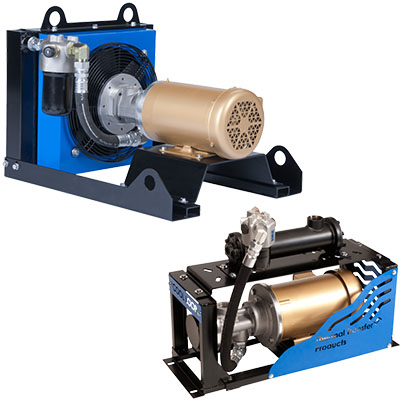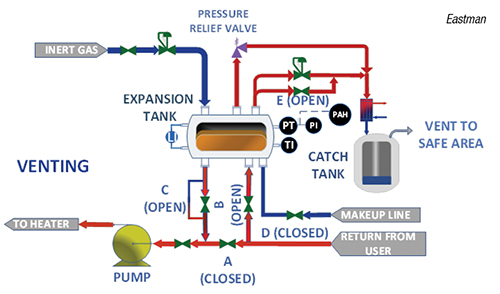5 Ways DVS Heat Transfer Systems Improve Energy Management in Automotive
Wiki Article
Discovering the Benefits and Applications of Heat Transfer Solutions in Modern Sector
Heat transfer systems play a vital function in modern-day sector. They incorporate numerous devices such as transmission, radiation, and convection, each adding to effective thermal administration. Industries like production and aerospace benefit significantly from these systems. As developments proceed, the combination of cutting-edge products and modern technologies guarantees to improve energy performance. This evolution raises essential concerns about the future ramifications for sustainability and operational prices throughout multiple fields. What exists ahead in this ongoing makeover?Comprehending Heat Transfer Concepts
Heat transfer concepts are essential to the operation of numerous industrial systems. These concepts include the mechanisms of convection, conduction, and radiation, each playing a vital function in managing thermal power. Understanding conduction entails evaluating how Heat relocates with solid products, while convection relate to Heat transfer in fluids, driven by fluid movement. Radiation, unique from the other 2, entails power transfer via electromagnetic waves. The efficiency of Heat transfer influences system performance, power consumption, and overall performance. Efficient thermal administration is essential in processes such as Heat, heating, and cooling healing. By understanding these principles, markets can maximize their procedures, decrease power costs, and improve devices long life, thus adding to an extra lasting and reliable industrial landscape.Secret Types of Heat Transfer Systems
While various industries use Heat transfer systems for diverse applications, a number of crucial kinds attract attention as a result of their details functions and performances. One of the most usual types include radiation, convection, and conduction systems. Conduction systems transfer Heat with direct get in touch with between materials, making them efficient in solid-state applications. Convection systems, on the various other hand, use fluid motion to transfer Heat, ideal for home heating or cooling down gases and liquids. Radiation systems operate without a medium, relying on electromagnetic waves to move Heat, suitable for high-temperature atmospheres. Each type offers distinct functions, enabling markets to tailor their Heat transfer remedies based upon functional demands, energy efficiency, and cost-effectiveness. Understanding these systems is vital for optimizing performance in different industrial settings.Industrial Applications of Heat Transfer Technologies
The application of Heat transfer modern technologies in sector plays a crucial function in improving power performance and enhancing procedures. DVS Heat Transfer Systems. By applying innovative Heat exchange systems, firms can significantly minimize their environmental influence while enhancing general efficiency. This assimilation not only cultivates sustainability however additionally aligns with contemporary governing and consumer needs for greener methodsEnergy Performance Improvements
As markets progressively prioritize sustainability, energy performance enhancements in Heat transfer technologies have actually become crucial for minimizing operational expenses and ecological effect. Boosted Heat exchangers, for circumstances, utilize sophisticated products and layouts to maximize thermal efficiency while lessening power consumption. Integrating variable rate drives in pumping systems enables for far better control of liquid flow, leading to substantial energy financial savings. The execution of smart sensors and automation provides real-time tracking, making it possible for changes that optimize energy use. In addition, waste Heat recovery systems record excess thermal power, transforming it into usable power. These improvements not just enhance power effectiveness yet additionally contribute to a more sustainable industrial landscape by reducing greenhouse gas discharges and sustaining conformity with ecological laws.Refine Optimization Techniques
Refine optimization strategies are critical in enhancing the efficiency and effectiveness of Heat transfer technologies in commercial applications. These strategies include refining procedures to optimize Heat transfer performance while lessening energy usage and operational costs. Approaches such as computational liquid characteristics (CFD) modeling enable designers to replicate and examine Heat transfer circumstances, identifying locations for enhancement. In addition, real-time surveillance systems can provide useful information on temperature level gradients and circulation prices, allowing modifications that optimize efficiency. Carrying out advanced control strategies, such as anticipating analytics, can improve system responsiveness to varying functional demands. By using these optimization methods, industries can accomplish greater thermal efficiency, minimized downtime, and improved item quality, inevitably bring about raised competitiveness in the marketplace.
Ecological Effect Reduction
While industrial Heat transfer innovations are essential for functional efficiency, their application likewise presents possibilities for significant ecological impact decrease. By boosting energy performance, these systems minimize gas intake, resulting in reduced greenhouse gas emissions. For example, advanced Heat exchangers can recuperate waste Heat, redirecting it to preheat incoming liquids, thereby minimizing power needs. Furthermore, the combination of Heat transfer modern technologies in renewable energy systems, such as solar thermal and geothermal applications, supports the change to lasting techniques. Industries that employ these technologies likewise gain from decreased operational prices and enhanced regulatory conformity. Overall, the tactical application of Heat transfer systems not just boosts performance yet also fosters a more sustainable commercial landscape, adding to global environmental objectives.Advantages of Efficient Heat Transfer Solutions
Efficient Heat transfer systems provide substantial advantages in contemporary sector, mainly via improved energy efficiency and cost reduction. By optimizing thermal management, these systems minimize power waste, causing lower functional prices (DVS Heat Transfer Systems). Services can accomplish greater sustainability and improved productivity.
Energy Effectiveness Improvements
As sectors increasingly prioritize sustainability and cost-effectiveness, power effectiveness renovations in Heat transfer systems have emerged as an important emphasis. Improved performance in these systems leads to decreased energy usage, making it possible for centers to operate more sustainably. By optimizing Heat transfer methods, markets can reduce waste Heat and achieve better thermal administration, significantly reducing their environmental impact. Advancements in innovations such as Heat exchangers and insulation materials contribute to improved efficiency and integrity. Executing energy-efficient Heat transfer options not only supports conformity with governing requirements however also cultivates a society of development within organizations. Eventually, these enhancements are important in aligning commercial operations with international energy conservation objectives, paving the method for a more lasting future in manufacturing and handling markets.Expense Reduction Opportunities
By maximizing Heat transfer systems, markets can reveal substantial expense decrease chances that enhance their lower line. Efficient Heat transfer reduces power consumption, bring about lower energy expenses and minimizing functional expenses. Furthermore, boosted system efficiency decreases the demand for repair and maintenance, furthermore saving costs with time. Enhanced Heat transfer can likewise extend equipment life-span, permitting firms to delay capital expenses on replacements. Moreover, waste Heat recovery systems can transform excess Heat right into usable power, further driving down expenses. These systems not only simplify processes but additionally add to sustainability campaigns, placing firms favorably in a significantly eco-conscious market. Overall, the monetary advantages of reliable Heat transfer systems are necessary and substantial for competitive advantage.Advancements in Heat Transfer Solutions
Just how can modern-day sector enhance its operations via innovative Heat transfer services? By embracing sophisticated products and modern technologies, sectors can substantially boost thermal performance and performance. Innovations such as nanofluids, which enhance Heat transfer capabilities past standard fluids, and phase modification materials that keep and release thermal power, are acquiring traction. Additionally, the integration of clever sensing units and IoT tools permits real-time tracking and optimization of Heat transfer processes, reducing waste and improving system responsiveness. Moreover, additive production strategies allow the development of look at this now more intricate Heat exchangers that optimize surface while lessening product usage. Jointly, these innovations drive operational efficiency and develop affordable advantages in numerous industries, including production, energy, and aerospace.The Role of Heat Transfer in Sustainability Initiatives
While the push for sustainability remains to reshape sectors, the function of Heat transfer modern technologies comes to be progressively crucial in achieving ecological goals. Reliable Heat transfer systems assist in energy performance by enhancing thermal monitoring in various procedures, considerably minimizing energy usage and greenhouse gas exhausts. Advanced Heat exchangers are used in commercial applications to reclaim waste Heat, therefore reducing power waste. Additionally, advancements such as stage change products boost thermal storage space, contributing to renewable resource assimilation. The fostering of sustainable liquids in Heat transfer systems can decrease environmental effect. By focusing on reliable Heat transfer, sectors not just improve operational performance however additionally straighten with international sustainability initiatives, fostering a cleaner, much more sustainable future.Often Asked Concerns
Just How Do Heat Transfer Equipments Influence Power Prices in Production?
Heat transfer systems significantly affect power expenses in manufacturing by improving see this here effectiveness, minimizing waste, and maximizing thermal monitoring. These enhancements cause reduce functional costs, inevitably profiting general productivity and productivity in commercial operations.What Upkeep Is Needed for Heat Transfer Solutions?
Maintenance for Heat transfer systems includes normal examinations, cleansing of elements, inspecting fluid degrees and conditions, replacing used parts, and guaranteeing proper insulation. These activities enhance effectiveness, extend life-span, and stop expensive break downs in operation.Exist Security Issues With Heat Transfer Systems?
Safety and security interest in Heat transfer systems consist of prospective leaks, pressure accumulation, and thermal dangers. Appropriate design, normal maintenance, and adherence to security protocols are necessary to mitigate these threats and guarantee risk-free procedure in commercial environments.
Just How Can I Choose the Right Heat Transfer System for My Service?
Choosing the appropriate Heat transfer system includes examining aspects such as efficiency, application requirements, budget plan restraints, and safety and security standards. A detailed evaluation of these aspects will certainly help guarantee suitable performance and integrity in business operations.What Prevail Failings in Heat Transfer Equipments and Their Reasons?

Understanding transmission involves examining how Heat moves with strong materials, while convection pertains to Heat transfer in liquids, driven by liquid activity. By optimizing Heat transfer approaches, industries can lessen waste Heat and achieve much better thermal monitoring, considerably lowering their ecological influence. Waste Heat recovery systems can change excess Heat right into usable energy, additionally driving i thought about this down prices. Advanced Heat exchangers are made use of in industrial applications to reclaim waste Heat, consequently minimizing energy waste. Usual failures in Heat transfer systems include leaks, corrosion, and inefficient Heat exchange.
Report this wiki page